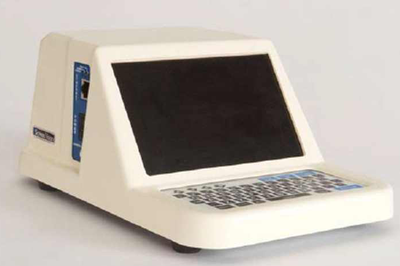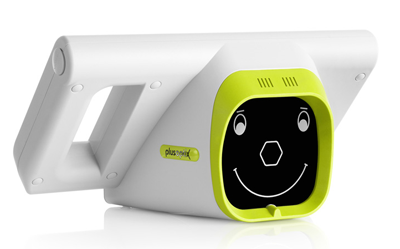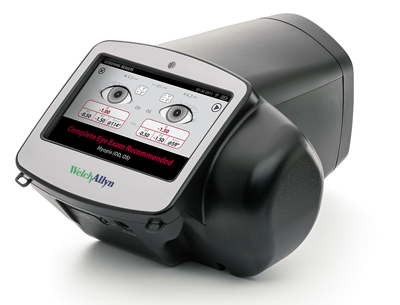By Christina L. Donaghy, BS; Scott A. Larson, MD
Background
Amblyopia is a maldevelopment of the visual cortex during infancy or early childhood that leads to decreased central vision in the affected eye. Left untreated, patients can have significant visual impairment that persists throughout life. The key to treatment success of amblyopia is early detection. The goal of vision screening is to detect poor vision or risk factors for poor vision at a time when effective therapy can be initiated.
The US Preventive Services Task Force currently recommends vision screening for children ages 3-5 years, however screening has been successfully implemented in infants as young as 6 months of age.1 The American Association for Pediatric Ophthalmology and Strabismus recommends that elective instrument-based photoscreening, described in detail below, be performed as early as 6 months of age, in the window of 6 months to 3 years.2 In 2011, the US Preventive Services Task Force concluded that insufficient evidence was available to support vision screening before age 3. However, Longmuir et al. published a study in 2013 that analyzed the effectiveness of photoscreening for amblyopia in children ages 6 months to 3 years.3 The study found that in this age range, the rate of unreadable images was 13.0%; the rate of positive screens referred for a complete eye examination was 3.3%, which is similar to the prevalence of amblyopia in the population; and the overall positive predictive value of screening was 86.6%.3 No statistical difference was identified between this age group and the 3 to 6-year-old children, supporting the use of vision screening in younger children. Additionally, Kirk et al. concluded that children identified with amblyopia before age 2 had post-treatment visual acuity outcomes that were, on average, one line better than children diagnosed between ages 2 to 4 years.4
Vision screening modalities either directly screen for amblyopia or screen for the risk factors associated with amblyopia. Direct screening requires the patient to reliably respond to the examiner to assess visual acuity using a vision chart. Instrument-based testing, on the other hand, does not test for a visual deficit directly but tests for common risk factors associated with amblyopia. An advantage of instrument-based testing is that it does not require much participation from the child and can be performed in preverbal infants.
Tests for Detecting Amblyopia
Visual Acuity Tests
Visual acuity tests directly screen for the presence of amblyopia. Visual acuity testing has a subjective component and therefore responses to visual acuity testing should be interpreted in the context of the patient’s age, ability, and level of cooperation. Ideally, the patient is able to identify by naming or matching the letters or symbols on a chart a fixed distance away. As patient participation is fundamental, visual acuity testing must be performed in cooperative children. It is commonly not possible to test visual acuity with a matching or naming test until the child is 3 years of age. Visual acuity testing in preverbal infants and toddlers is most commonly performed by assessing the fixation preference or by using forced preferential looking test such as Teller Cards. Testing distance must be accurate and appropriate for the chart used. Commonly used vision charts for matching and naming tests include Sloan, HOTV, Lea symbols, and Patti Pics.5 Each eye must be tested individually. Stick-on eye patches or pediatric occlusion glasses are useful to adequately cover the eye not being tested. Kennedy et al. evaluated the efficacy of traditional vision screening, including both visual acuity and stereo acuity testing, to detect amblyopia in 1,245 kindergarteners. The results showed that, vision screening identified 94.2% of patients with visual defects.6
Optical Tracking
The presence of amblyopia causes very small abnormalities in fixation in the amblyopic eye. Optical tracking is a method for measuring eye movement and has been proposed as a way to detect small abnormalities in fixation, and by extension, the presence of amblyopia. Unfortunately most eye tracking devices using the corneal reflection or pupil are not sensitive enough to detect these small fixation changes. A reflection from the birefringent Henle fibers of fovea has been imaged by one device that may been sensitive enough to detect amblyopia.7 Currently this device is being tested in a clinical setting in children and is not available to the public, but it may show future promise.
Optokinetic Nystagmus
Optokinetic nystagmus is a reflex that develops around 6 months of life. It is a horizontal rapid re-fixation movement that is seen when the patient attempts to follow a moving object. The reflex is tested by rotating an optokinetic drum in front of the patient. Optokinetic nystagmus can be used as a crude evaluation of an intact visual system. Lack of optokinetic nystagmus in one eye suggests amblyopia. However, this test lacks the precision needed to screen for amblyopia.
Neutral Density Filter Testing
Neutral density filter testing can be used identify amblyopia and help distinguish strabismic amblyopia from other causes. A neutral density filter equally reduces the intensity of all wavelengths of light. Von Noorden and Burian compared healthy eyes with amblyopic eyes due to either strabismus or a known organic pathology such as macular degeneration, optic nerve atrophy, and chorioretinitis.8 They demonstrated that use of a neutral density filter in healthy eyes reduced the visual acuity by a constant amount, while in eyes with strabismic amblyopia, vision was only slightly reduced, stayed the same, or actually improved. Vision in the amblyopic group with organic pathology showed a marked reduction in visual acuity with use of the filter. The authors concluded that neutral density filter testing could be used to identify amblyopic eyes and to differentiate causation between strabismus and other pathologies.8 This test has not been incorporated into screening programs for amblyopia to our knowledge.
Visual Evoked Potentials
Visual evoked potentials (VEP) are changes in voltage measured with sensitive electrodes on the scalp over the occipital lobes. The voltage changes when the eyes view a visual stimulus. In theory, measuring the brain function directly may eliminate the need for a behavioral response from the child being tested. The use of VEP in vision screening has been tested by showing subjects progressively smaller sized visual stimuli until the VEP becomes extinguished; this threshold corresponds to the minimum angle of resolution for the child. This is known as a sweep VEP. In practice, for vision screening devices based on VEP, the child must be cooperative enough to fixate for at least 30 seconds on a screen and tolerate the electrode array being attached to the head. Simon et al. tested a version of the VEP device to screen for amblyopia in a group of children 6 months to 5 years of age, and compared the device to a gold standard eye examination. The test could be completed by 94% of children, and they found a sensitivity of 97% at a specificity of 80%.9
Tests That Detect Amblyopia: Risk Factors
There are ocular pathologies that often accompany amblyopia but may occur in the absence of amblyopia such as anisometropia, strabismus, media opacity, or reduced stereovision. Screening programs based on detection of these risk factors for amblyopia have been instituted cross the country using devices that can quickly screen for these factors at low incremental cost.
Photoscreening
Photoscreening is the interpretation of photographs that may show ocular defects associated with amblyopia. A photograph of the child’s eyes is analyzed to detect pathology such as refractive error, media opacities, strabismus, or other external eye abnormalities such as ptosis. The photo can be interpreted by an ophthalmologist, a central reading center, or by computer.2 Based on predetermined referral criteria, a selected population of patients with a positive screen are then referred to an ophthalmic professional for a comprehensive eye examination. In a 9-year retrospective analysis of 147,809 children, Longmuir et al. determined the positive predictive value (PPV) of photoscreening was 94.2%.10 The most commonly identified pathologies were refractive error (83.9%) and strabismus (12.1%). Only less than 1% of referred children were found to have a media opacity, but photoscreening had a 100% PPV for identifying media opacities.10 Currently available photoscreeners include the iScreen (Figure 1) and Plusoptix, which also includes autorefraction technology (Figure 2).5

Figure 1. iScreen Vision photoscreening technology

Figure 2. Plusoptix S12 Mobile Screener
Most modern photoscreening devices allow the user to set the specificity and sensitivity criteria in order to tailor the number of referrals that will be generated depending on the needs of the screening program. The companies that provide the device may also provide an interpretation of the images that involves a subscription fee.
Autorefraction
Autorefraction is automated retinoscopy that determines the refractive error of each eye. Autorefraction requires the subject to remain fairly still during the examination, and therefore requires more patient cooperation than photoscreening, depending on the speed of the machine. Autorefraction evaluates each eye independently, which limits the ability to screen for strabismus.2 Kemper et al. determined that for children ages 3-5 years, the sensitivity and specificity of monocular autorefraction for detecting amblyogenic pathology is 88% and 58%, respectively.11 The sensitivity for children younger than 3 years was 80%, though only 49% of the photos in this age group were considered “testable” and subsequently analyzed.11 Some of the currently available devices based on autorefraction technology include the Retinomax handheld refractor and keratometer, SureSight Vision Screener and Spot Vision Screener.5 The Vision in Preschoolers Study Group identified the Retinomax autorefractor and the SureSight Vision Screener as more sensitive screening methods to detect amblyopia when compared with Lea Symbols visual acuity and the Stereo Smile II.12

Figure 3. Spot Vision Screener.
Screening Programs
A variety of screening programs exist throughout the United States. No single progam is used nationwide. Programs are run by volunteers, schools, and general pediatricians. Most states have laws requiring a vision screening examiation prior to enrolling in school. The Lions Clubs International is a service organization that has provided eye care services for nearly 100 years. They organize vision screenings that aim to identify amblyopia in preschool age children. For example, the Lions Club of Iowa partners with the University of Iowa, Department of Ophthalmology and Visual Sciences, and the University of Iowa Sight (UISight) program to host vision screenings at local community centers. They screen children ages 6 months to 6 years via photoscreening for amblyogenic risk factors.
There are also many school-based programs that perform vision screening prior to entering kindergarten. The Vision in Preschoolers Study Group determined that trained nurses and lay screeners have similar efficacy when performing preschool vision screenings.12 Lay screeners were able to successfully identify children in need of a more comprehensive ophthalmic examination with similar sensitivities compared with trained nurses. Requirements for vision screening in schools vary by state with only 8 states having no such policy.13
Vision screening is also performed by general pediatricians. The American Academy of Pediatrics (AAP) recommends that pediatricians begin evaluating visual acuity as early as practically possible, which is generally interpreted as 3 years of age.14 To assess vision in children from birth to 3 years of age, the AAP recommends observing the patient’s ability to fix and follow objects. The AAP also endorses photoscreening and autorefraction to be performed electively by pediatricians in children ages 6 months to 3 years, recognizing that adoption of this technology is highly dependent on insurance companies’ payment policies for these services.2
Ocular photographs obtained via electronic applications are the basis of the most productive pediatric vision screening programs. In 2012, Arnold et al. described a prospective study using a variety of portable vision screening devices including the Plusoptix, iScreen, and Spot screeners to detect amblyopia risk factors, and identified sensitivities ranging from 72%-84%.15 In 2013, Vaughan et al. described the use of the iCheckKids photoscreening application available on iPhone to test preschool age children for refractive error and strabismus.16 Although none of the smartphone applications have currently been approved for vision screening, improvements in diagnostic accuracy are on the horizon. Smartphone photoscreening applications would allow widespread distribution of the technology needed to identify children at risk for amblyopia. Upcoming technologic advances have the potential to revolutionize pediatric vision screening.
The advantage of screening programs based on autorefraction or photoscreening technology is the low incremental cost. Once the program has invested in the device, the additional cost per screening event is quite low. Using comprehensive eye examinations by an ophthalmologist or optometrist to screen for amblyopia would be the most expensive and least efficient screening method. The comprehensive eye exam should be reserved as the confirmatory test for those that have a positive screen using other modalities.
Conclusion
Amblyopia is common in the pediatric population, affecting 2%-5% of children.17 With early screening efforts and appropriate treatment, good visual outcomes can be achieved. The US Preventive Services Task Force recommends vision screening for all children ages 3 to 5 years. The AAP and AAPOS endorse instrument-based vision screening for patients beginning at age 6 months. With the help of volunteer-based organizations, school programs, and general pediatricians, successful vision screening programs are widely available. Technological advances currently available and on the horizon may make vision screening even more readily accessible.
Resources
American Academy of Ophthalmology
Amblyopia EyeWiki
Photo Screening EyeWiki
Vision Screening Policy Statement
Vision Screening EyeWiki
AAPOS
Vision Screening
Vision Screening recommendations
State by State Vision screening requirements
AAP
Policy Statement for Eye examinations by Pediatricians
Photoscreening Devices
iScreen
Plusoptix
Go Check Kids
Video Reviews by Dr. Robert W. Arnold
Autorefractors
Spot
Retinomax
Suresight
Video Reviews by Dr. Robert W. Arnold
Visual evoked potential (Sweep VEP)
Diopsys
Examples of Vision Screening Programs
Tennessee Lions Vision Screening
Iowa KidSight
Oregon State Elks Preschool Vision Screening
References
- Force USPST. The Guide to Clinical Preventative Services2014. Available from: http://www.ahrq.gov/professionals/clinicians-providers/guidelines-recommendations/guide/cpsguide.pdf.
- Miller JM, Lessin HR, American Academy of Pediatrics Section on O, Committee on P, Ambulatory M, American Academy of O, et al. Instrument-based pediatric vision screening policy statement. Pediatrics. 2012;130(5):983-6.
- Longmuir SQ, Boese EA, Pfeifer W, Zimmerman B, Short L, Scott WE. Practical community photoscreening in very young children. Pediatrics. 2013;131(3):e764-9.
- Kirk VG, Clausen MM, Armitage MD, Arnold RW. Preverbal photoscreening for amblyogenic factors and outcomes in amblyopia treatment: early objective screening and visual acuities. Archives of Ophthalmology. 2008;126(4):489-92.
- David I Silbert NSM, Laura Olson. Pediatric Vision Screening. EyeWiki [Internet]. 2014. Available from: http://eyewiki.org/Pediatric_Vision_Screening.
- Kennedy R, Sheps SB, Bagaric D. Field trial of the Otago photoscreener. Canadian Journal of Ophthalmology. 1995;30(4):193-7.
- Irsch K, Gramatikov BI, Wu YK, Guyton DL. New pediatric vision screener employing polarization-modulated, retinal-birefringence-scanning-based strabismus detection and bull's eye focus detection with an improved target system: opto-mechanical design and operation. Journal of Biomedical Optics. 2014;19(6):067004.
- Von Noorden GK, Burian HM. Visual acuity in normal and amblyopic patients under reduced illumination. I. Behavior of visual acuity with and without neutral density filter. AMA Archives of Ophthalmology. 1959;61(4):533-5.
- Simon JW, Siegfried JB, Mills MD, Calhoun JH, Gurland JE. A new visual evoked potential system for vision screening in infants and young children. J AAPOS. 2004;8(6):549-54.
- Longmuir SQ, Pfeifer W, Leon A, Olson RJ, Short L, Scott WE. Nine-year results of a volunteer lay network photoscreening program of 147 809 children using a photoscreener in Iowa. Ophthalmology. 2010;117(10):1869-75.
- Kemper AR, Keating LM, Jackson JL, Levin EM. Comparison of monocular autorefraction to comprehensive eye examinations in preschool-aged and younger children. Archives of Pediatrics & Adolescent Medicine. 2005;159(5):435-9.
- Vision in Preschoolers Study G. Preschool vision screening tests administered by nurse screeners compared with lay screeners in the vision in preschoolers study. Investigative Ophthalmology & Visual Science. 2005;46(8):2639-48.
- State-by-state Vision Screening Requirements [Internet]. American Association for Pediatric Ophthalmology and Strabismus. 2011. Available from: http://www.aapos.org/resources/state_by_state_vision_screening_requirements/.
- Jack Swanson EGB. Eye examination in infants, children, and young adults by pediatricians. Pediatrics. 2003;111(4 Pt 1):902-7.
- Arnold RW, Arnold AW, Armitage MD, Shen JM, Hepler TE, Woodard TL. Pediatric photoscreeners in high risk patients 2012: a comparison study of Plusoptix, Iscreen and SPOT. Binocular Vision & Strabology Quarterly, Simms-Romano's. 2013;28(1):20-8.
- Joannah Vaughan TD, David Huang. Photoscreening for Refractive Error and Strabismus With a Smartphone App. American Academy of Pediatrics National Conference and Exhibition [Internet]. 2013. Available from: https://aap.confex.com/aap/2013/webprogrampress/Paper20979.html.
- Kemper AR, Margolis PA, Downs SM, Bordley WC. A systematic review of vision screening tests for the detection of amblyopia. Pediatrics. 1999;104(5 Pt 2):1220-2.